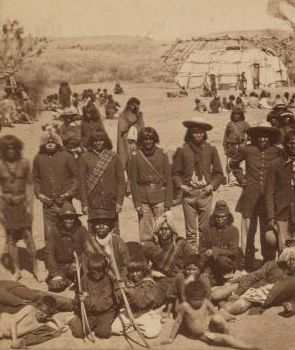The site chosen for Central Park was distant from the built area of the city: the cost of Manhattan real estate precluded buying land for a large park in the densely built lower part of the island, and this would be true in other cities as they acquired land for parks throughout the remainder of the century. Still, the process of assembling land for park purposes was a visionary accomplishment, removing 9,792 standard 25 × 100 foot Manhattan building lots and reserving them for public use.
The post Building Central Park appeared first on OUPblog.
By Stephen Pevar

Chiefs at Verde Reservation, Arizona. Source: NYPL Labs Stereogranimator.
How would you feel if the government confiscated your land, sold it to someone else, and tried to force you to change your way of life, all the while telling you it’s for your own good? That’s what Congress did to Indian tribes 125 years ago today, with devastating results, when it passed the
Dawes Act.
During the 1800s, white settlers moved west by the tens of thousands, and the US cavalry went with them, battling Indian tribes along the way. One by one, tribes were forced to relinquish their homelands (on which they had lived for centuries) and relocate to reservations, often hundreds of miles away. By the late 1800s, some three hundred reservations had been created.
The purpose of the reservation system was, for the most part, to remove land from the Indians and to separate the Indians from the settlers. Reservations were usually created on lands not (yet) coveted by non-Indians. By the late 1800s, however, settlers were nearly everywhere, and Congress needed to develop a new strategy to prevent further bloodshed.
The government decided that instead of separating Indians from white society, Indians should be assimilated into white society. Assimilation of the Indians and the destruction of their reservations became the new federal goal.
Two very different social forces helped shaped this new policy: greed and humanitarianism. Many whites wanted Indian land and knew that they would have an easier time obtaining it if Indian tribes disappeared. This greed prompted Congress to pass the Dawes Act, also known as the General Allotment Act, in February 1887. The Dawes Act was also favored by many non-Indian social reformers who were aware that Indians were suffering unmercifully under the government’s existing reservation policies, and they sincerely believed that the best way to help Indians overcome their plight and their poverty was by encouraging assimilation. Although their motives differed, both groups pressured Congress to pass the Dawes Act. The objectives of the Act, as the US Supreme Court has noted, “were simple and clear cut: to extinguish tribal sovereignty, erase reservation boundaries, and force the assimilation of Indians into the society at large.” Indian tribes had no say in the matter and were not even consulted.
Most Indian tribes had no concept of private land ownership. Rather, land was communally owned and everyone worked together to gather what they could from the land and shared its bounty. In order to compel assimilation of the Indians, a scheme was developed that would undermine Indian life and culture at its core: individual Indians would be forced to own land for private use. Indians would be converted into capitalists.
To accomplish the new policy of assimilation, the Dawes Act authorized the President of the United States to divide communally-held tribal lands into separate parcels (“allotments”). Each tribal member was to be assigned an allotment and, after a twenty-five-year “trust” period, would be issued a deed to it, allowing the owner to sell it. Once the allotments were issued, the remaining tribal land (the “surplus” land) would be sold to non-Indian farmers and ranchers. Congress hoped that by allowing non-Indians to live on Indian reservations, the goals of the settlers and those of the humanitarian social reformers could both be satisfied: land would become available for non-In



